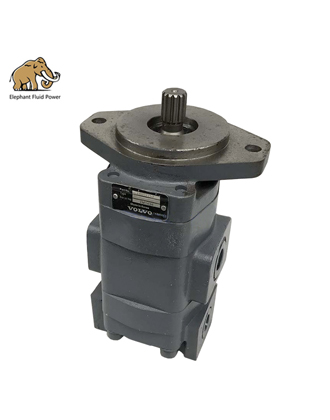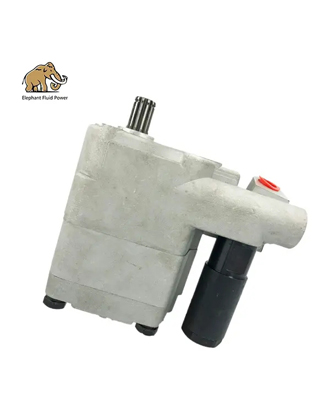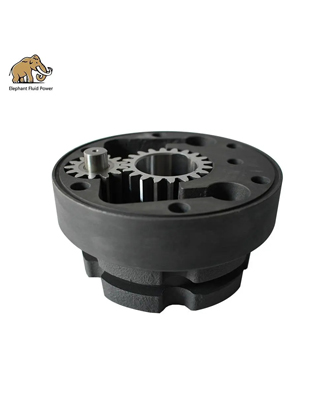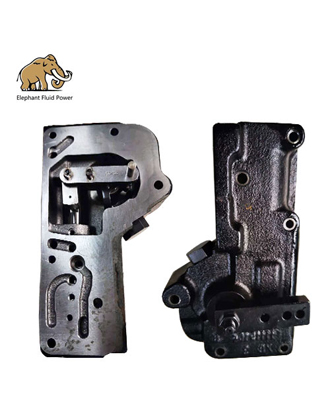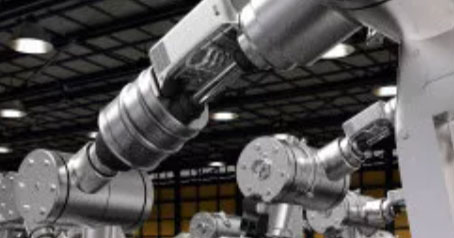Application of hydraulic piston pump
The Piston pump is an important device of the hydraulic system. It relies on the plunger to reciprocate in the cylinder to change the volume of the sealed working volume to achieve oil absorption and oil pressure. The plunger pump has the advantages of high rated pressure, compact structure, high efficiency and convenient flow adjustment. It is widely used in high pressure, large flow and flow adjustment occasions, such as hydraulic machines, construction machinery and ships.
Axial plunger pump is a plunger pump in which the reciprocating direction of the piston or plunger is parallel to the central axis of the cylinder. Axial plunger pumps use the volume change caused by the plunger reciprocating in the plunger hole parallel to the transmission shaft to work. Because the plunger and plunger hole are round parts, high precision can be achieved during processing, so the volumetric efficiency is high, the operation is stable, the flow is uniform, the noise is low, and the working pressure is high. More sensitive, more complex structure, higher cost.
The straight shaft swash plate type plunger pump is divided into two types of pressure-supply type self-priming type. Most of the pressure-supply hydraulic pumps use a pneumatic tank, and some hydraulic pumps have a replenishment sub-pump to provide pressure oil to the hydraulic pump inlet. The self-priming hydraulic pump has a strong self-priming capacity and does not require external oil supply. The hydraulic oil tank that relies on air pressure to supply oil must be operated after the hydraulic stain tank reaches the air pressure after starting the machine. For example, when the hydraulic tank pressure is insufficient, it will act as a machine, which will cause the pull-off phenomenon between the hydraulic pump and the slide whip, which will cause abnormal wear of the return plate and pressure plate in the pump body.
Radial VICKERS plunger pumps can be divided into two categories: valve distribution and shaft distribution. Valve distribution radial piston pump has high failure rate and efficiency
Inferior disadvantages. The axial flow radial plunger pump developed in the 70s and 80s in the world has overcome the shortage of the valve flow radial plunger pump. Due to the structural characteristics of the radial pump, Shaanxi has determined that the axial flow radial piston pump is more impact-resistant, longer in life and higher in control accuracy than the axial piston pump. The variable stroke short pump variable is achieved by changing the eccentric distance of the stator under the action of the variable plunger and the limit plunger. short. And the variable mechanism is designed for high-pressure operation, which is controlled by a control valve. Therefore, the response speed of the pump is fast. The radial structure design overcomes problems such as eccentric wear of axial piston pump shoes. It greatly improves its impact resistance.
Hydraulic plunger pump relies on air pressure to supply the hydraulic oil tank. After starting the machine each time, the hydraulic stain tank must be used before operating the machine. The straight shaft swash plate type plunger pump is divided into two types of pressure-supply type self-priming type. Most of the pressure-supply hydraulic pumps use a pneumatic tank, and some hydraulic pumps have a replenishment sub-pump to provide pressure oil to the hydraulic pump inlet. The self-priming hydraulic pump has a strong self-priming capacity and does not require external oil supply. For self-priming plunger pumps, the oil in the hydraulic oil tank must not be lower than the lower limit of the oil standard, and a sufficient amount of hydraulic oil must be maintained. The higher the cleanliness of the hydraulic oil, the longer the service life of the hydraulic pump.
 French
French
 Portuguese
Portuguese
 Russian
Russian
 German
German
 Spanish
Spanish
 Japanese
Japanese
 Korean
Korean
 Irish
Irish
 Greek
Greek
 Turkish
Turkish
 Italian
Italian
 Danish
Danish
 Romanian
Romanian
 Indonesian
Indonesian
 Czech
Czech
 Afrikaans
Afrikaans
 Swedish
Swedish
 Polish
Polish
 Basque
Basque
 Catalan
Catalan
 Esperanto
Esperanto
 Hindi
Hindi
 Lao
Lao
 Albanian
Albanian
 Amharic
Amharic
 Armenian
Armenian
 Azerbaijani
Azerbaijani
 Belarusian
Belarusian
 Bengali
Bengali
 Bosnian
Bosnian
 Bulgarian
Bulgarian
 Cebuano
Cebuano
 Chichewa
Chichewa
 Corsican
Corsican
 Croatian
Croatian
 Dutch
Dutch
 Estonian
Estonian
 Filipino
Filipino
 Finnish
Finnish
 Frisian
Frisian
 Galician
Galician
 Georgian
Georgian
 Gujarati
Gujarati
 Haitian
Haitian
 Hausa
Hausa
 Hawaiian
Hawaiian
 Hebrew
Hebrew
 Hmong
Hmong
 Hungarian
Hungarian
 Icelandic
Icelandic
 Igbo
Igbo
 Javanese
Javanese
 Kannada
Kannada
 Kazakh
Kazakh
 Khmer
Khmer
 Kurdish
Kurdish
 Kyrgyz
Kyrgyz
 Latin
Latin
 Latvian
Latvian
 Lithuanian
Lithuanian
 Luxembourg
Luxembourg
 Macedoniar
Macedoniar
 Malagasy
Malagasy
 Malay
Malay
 Malayalam
Malayalam
 Maltese
Maltese
 Maori
Maori
 Marathi
Marathi
 Mongolian
Mongolian
 Burmese
Burmese
 Nepali
Nepali
 Norwegian
Norwegian
 Pashto
Pashto
 Persian
Persian
 Punjabi
Punjabi
 Serbian
Serbian
 Sesotho
Sesotho
 Sinhala
Sinhala
 Slovak
Slovak
 Slovenian
Slovenian
 Somali
Somali
 Samoan
Samoan
 Scots Gaelic
Scots Gaelic
 Shona
Shona
 Sindhi
Sindhi
 Sundanese
Sundanese
 Swahili
Swahili
 Tajik
Tajik
 Tamil
Tamil
 Telugu
Telugu
 Thai
Thai
 Ukrainian
Ukrainian
 Urdu
Urdu
 Uzbek
Uzbek
 Vietnamese
Vietnamese
 Welsh
Welsh
 Xhosa
Xhosa
 Yiddish
Yiddish
 Yoruba
Yoruba
 Zulu
Zulu

